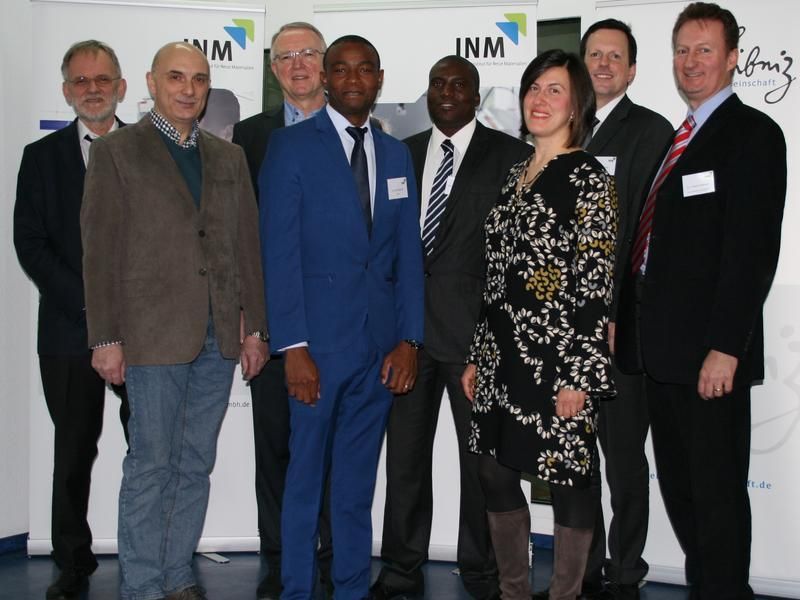Cooperation with Namibia underway
Natural resources as a basis for new materials
The INM – Leibniz Institute for new materials officially began its collaborative effort with the University of Namibia (UNAM) by holding a kick-off workshop. The aim of the joint project, NaMiComp, which is funded by the German Federal Ministry for Economic Cooperation and Development, is to analyze Namibia’s locally available natural resources and then use them as a basis for new materials for industrial applications. INM and UNAM are working together on the NaMiComp project in order to establish and strengthen research competence in materials science at UNAM. In the long term, the aim is to build an on-site materials science institute at the University of Namibia.

f.l.: Gerhard Wenz, Saar Uni, Bernd Reinhard, INM, Günter Weber, INM, Erold Naomab, UNAM, Kenneth Matengu, UNAM, Aránzazu del Campo, , INM, Roland Rolles, Saar Uni, Carsten Becker-Willinger, INM.
INM
The two-day long workshop, which was held at the INM, was the inaugural event for building this cooperation. Further multi-day workshops, reciprocal visits by experts, field surveys and learning cafés are set to follow.
“We’re delighted that this collaborative effort is now gaining pace,” says Günter Weber, INM’s Business Director. “Many different skills are needed to transform a natural product into a commercially profitable material. This starts with the analysis of the different types of wood, and includes the actual material and product development right through to the marketing of potential products.”
The example of acacia trees and shrubs should be highlighted to demonstrate how this biomass can be used to produce sustainable, fire resistant building materials for use in cost-effective housing construction. The large number of acacia bush-invader in Namibia has now become an environmental issue.
Kenneth Kamwi Matengu, Pro-Vice Chancellor of the University of Namibia explains: “We have found a strong German partner in INM. This partnership will allow us to further our University’s research mission and to contribute to a commercial solution for the further processing of acacia wood into a variety of commercial products. Now that this project is underway, we have the opportunity to bring our joint vision a step closer to reality.”
Organizations
Other news from the department science

Get the chemical industry in your inbox
From now on, don't miss a thing: Our newsletter for the chemical industry, analytics, lab technology and process engineering brings you up to date every Tuesday and Thursday. The latest industry news, product highlights and innovations - compact and easy to understand in your inbox. Researched by us so you don't have to.







![[Fe]-hydrogenase catalysis visualized using para-hydrogen-enhanced nuclear magnetic resonance spectroscopy](https://img.chemie.de/Portal/News/675fd46b9b54f_sBuG8s4sS.png?tr=w-712,h-534,cm-extract,x-0,y-16:n-xl)















































